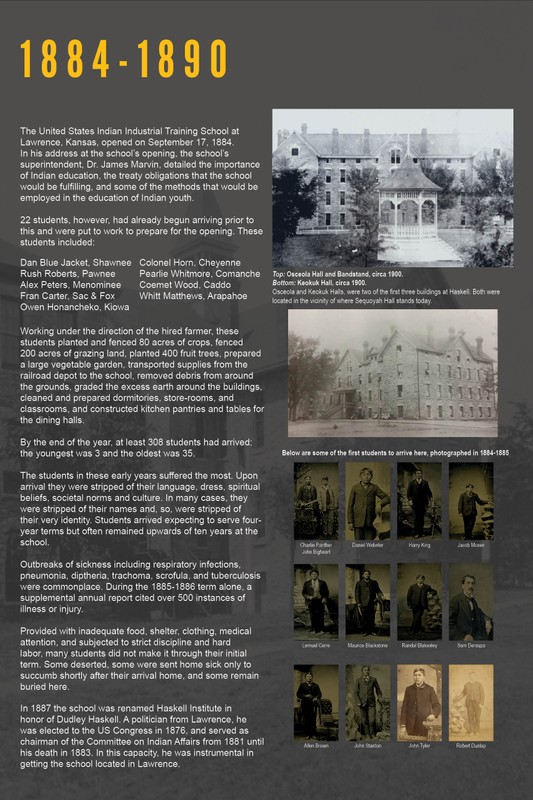1884-1890
Introduction
Text-to-speech Audio
The United States Indian Industrial Training School at Lawrence, Kansas, opened on September 17, 1884. In his address at the school’s opening, the school’s superintendent, Dr. James Marvin, detailed the importance of Indian education, the treaty obligations that the school would be fulfilling, and some of the methods that would be employed in the education of Indian youth.
Images

Backstory and Context
Text-to-speech Audio
The United States Indian Industrial Training School at Lawrence, Kansas, opened on September 17, 1884. In his address at the school’s opening, the school’s superintendent, Dr. James Marvin, detailed the importance of Indian education, the treaty obligations that the school would be fulfilling, and some of the methods that would be employed in the education of Indian youth.
22 students, however, had already begun arriving prior to this and were put to work to prepare for the opening. These students included:
Dan Blue Jacket, Shawnee
Rush Roberts, Pawnee
Alex Peters, Menominee
Fran Carter, Sac & Fox
Owen Honancheko, Kiowa
Colonel Horn, Cheyenne
Pearlie Whitmore, Comanche
Coemet Wood, Caddo
Whitt Matthews, Arapahoe
Working under the direction of the hired farmer, these students planted and fenced 80 acres of crops, fenced 200 acres of grazing land, planted 400 fruit trees, prepared a large vegetable garden, transported supplies from the railroad depot to the school, removed debris from around the grounds, graded the excess earth around the buildings, cleaned and prepared dormitories, store-rooms, and classrooms, and constructed kitchen pantries and tables for the dining halls.
By the end of the year, at least 308 students had arrived; the youngest was 3 and the oldest was 35.
The students in these early years suffered the most. Upon arrival they were stripped of their language, dress, spiritual beliefs, societal norms and culture. In many cases, they were stripped of their names and, so, were stripped of their very identity. Students arrived expecting to serve four-year terms but often remained upwards of ten years at the school.
Outbreaks of sickness including respiratory infections, pneumonia, diphtheria, trachoma, scrofula, and tuberculosis were commonplace. During the 1885-1886 term alone, a supplemental annual report cited over 500 instances of illness or injury.
Provided with inadequate food, shelter, clothing, medical attention, and subjected to strict discipline and hard labor, many students did not make it through their initial term. Some deserted, some were sent home sick only to succumb shortly after their arrival home, and some remain buried here.
In 1887 the school was renamed Haskell Institute in honor of Dudley Haskell. A politician from Lawrence, he was elected to the US Congress in 1876, and served as chairman of the Committee on Indian Affairs from 1881 until his death in 1883. In this capacity, he was instrumental in getting the school located in Lawrence.
Cite This Entry
Campbell, Travis. "1884-1890." Clio: Your Guide to History. November 1, 2023. Accessed March 31, 2025. https://theclio.com/entry/174009/tour/2

